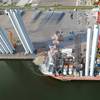The hull of the P-53 arrived off the coast of Rio Grande (state of Rio Grande do Sul) on September 4 and was berthed to the QUIP´s Quay (Port of Rio Grande) on September 20, according to Petrobras. Hundreds of people, among whom Rio Grande and neighboring town residents, witnessed the vessel's arrival. For safety reasons, the local power utility, the Companhia Estadual de Energia Elétrica (CEEE), interrupted power supply to the city of São José do Norte during the P-53's passage under the aerial cables that supply the town.
The platform's entrance in the port's channel, initially scheduled for September 10, was postponed for a few days due to operational problems of tugs during the hull-towage arrangement maneuverability tests and, also, because of the adverse weather conditions in this region. Tugboat device and entrance procedure reassessment led to the addition of two more tugboats - brought from the Itajaí (Santa Catarina) and Paranaguá (Paraná) ports - to the formation. Tests and simulations done with this new 7-tugboat arrangement and new procedures guaranteed a smooth, successful operation, carried out in compliance with the Petrobras safety guidelines.
The P-53's hull left Singapore towards Brazil on July 2, and was towed by three tugboats. Before setting sail, the vessel had left the Keppel shipyard to undergo sea testing and to be prepared for transportation. After its arrival in Rio Grande, the modules built in Niterói (RJ), Rio Grande, and Singapore will be lifted and integrated to the platform.
The P-53 will be capable of producing 180,000 barrels of oil and six million cubic meters of gas per day, in addition to power generation of 92 megawatts. The platform will be installed at the Marlim Leste field, in the Campos Basin, in Rio de Janeiro, at a water depth of 1,080 meters.
The hull (ex-oil tanker Settebello) had been at the shipyard since March 2005, where it was converted and received the world's biggest turret (tower that receives the flexible production, injection, and control lines and the mooring lines); engine and pump room systems; full paints scheme; structural reinforcements for production; facility, accommodation, and office modules; three lifeboat stations; a helideck (platform where helicopters land on the rig), the telecommunication tower; and the flare (gas burner).
Featured videos

Inmarsat Enhances Service to Drive Digitalization

Inside the Electrified Truckable Tug

Tracking Foreign Vessels Working in the U.S. Jones Act Market
Subscribe for
Maritime Reporter E-News
Maritime Reporter E-News is the maritime industry's largest circulation and most authoritative ENews Service, delivered to your Email five times per week









